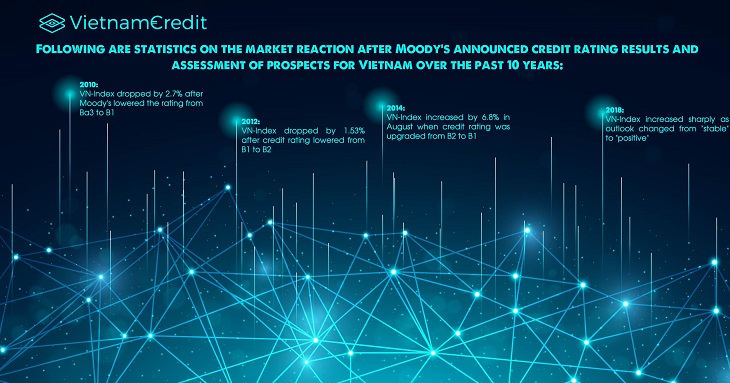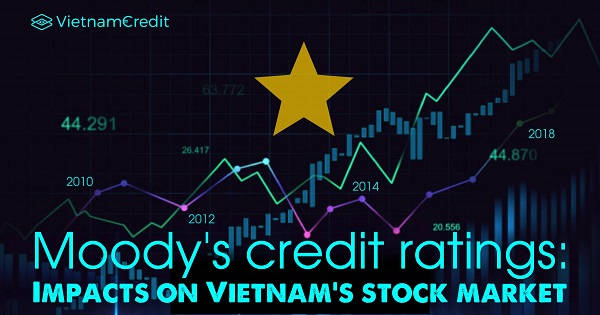Moody's has just announced that it would keep Vietnam's credit rating at Ba3 but degrade the country’s outlook to Negative.
On December 18, the credit rating agency Moody's Investors Service (Moody's) announced the maintenance of Vietnam's national credit rating at Ba3 for domestic and foreign currency issuances, and premium unsecured loans. At the same time, Moody's adjusted the outlook to Negative, ending the period of putting Vietnam's credit records in the downgrade tracking list from October 9, 2019.
Immediately after the announcement of Moody's, the Ministry of Finance responded that Moody's downgrades Vietnam's credit outlook based on only an individual incident to the Government's contingent debt liability, ignoring the overall achievement that Vietnam has got.
With Moody's move, a question that many investors are concerned about is how the stock market usually responds after the release of rating information. According to statistics in the last 10 years, the stock market tended to decrease after Moody's lowered the credit rating, and vice versa, the market increased sharply after receiving positive information from this credit rating agency.
Following are statistics on the market reaction after Moody's announced credit rating results and assessment of prospects for Vietnam over the past 10 years:
2010: VN-Index dropped by 2.7% after Moody's lowered the rating from Ba3 to B1
On December 15, 2010, Moody's lowered the credit rating for Vietnamese bonds from Ba3 to B1 and maintained the "negative" outlook. The reason given by Moody's at that time was the increasing risk of balance-of-payments crisis, inappropriate monetary and foreign exchange policies as well as Vinashin's debt.
Responding to that information, in the trading session of December 16, Vietnam stock market dropped. Specifically, the VN-Index fell 13.3 points to 480.2 points, equivalent to a 2.7% reduction. In the following sessions, Vietnam's stock market fluctuated slightly and closed in December 2010 at 484.7 points, down nearly 9 points compared to the date of credit rating announcement.
2012: VN-Index dropped by 1.53% after credit rating lowered from B1 to B2
On September 28, 2012, the credit rating for government bonds was downgraded by Moody's from B1 to B2 due to concerns about medium-term economic growth as well as risks to the banking system. In addition, Vietnam’s outlook was remained "stable" and short-term ratings were not affected.
At that time, according to Moody's, the two main reasons mentioned were risks in the Government deeply intervening in the debt restructuring process of the banking system, affecting financial health. Along with that, economic growth in the medium term was lower than forecast due to the influence of the credit institution system.
Similar to 2010, on October 1 this year, the market dropped after Moody's announcement. VN-Index fell 6.02 points to 386.55 points, equivalent to a decrease of 1.53%.
In the following sessions, VN-Index fluctuated and recorded the strongest increase of 7.66 points, equal to 1.96% on October 16. At the end of October 2012, VN-Index closed at 388.42 points, a slight decrease of 4.15 points compared to the time when Moody's announced the rating.

2014: VN-Index increased by 6.8% in August when credit rating was upgraded from B2 to B1
On July 29, 2014, Moody's raised a credit rating level for unsecured bonds with high priority and rated Vietnam's issuer from B2 to B1 with the prospect of "stable".
In the session on July 30, 2014, VN-Index decreased by 2.91 points, equivalent to 0.49%, to 589.3 points. However, the market increased sharply by 6.74 points to 596.07 points after that, equivalent to a 1.14% increase. In August 2014, Vietnam's stock market was positive, closing August 29 at 636.65 points, up nearly 6.8% compared to the end of July.
2018: VN-Index increased sharply as outlook changed from “stable” to “positive”
On August 11, 2018, Moody's continued to upgrade Vietnam’s credit rating from B1 to Ba3, with the prospect changing from "stable" to "positive".
The firm said the Ba3 rating reflected Vietnam’s strong growth potential, thanks to the increasingly rational use of labor and capital in the economy. Government debt was also declining thanks to long-term bonds and reduced dependence on foreign currency debt. The health of the banking system had improved and was expected to be maintained good.
The positive information of Moody's also partly affected investors in the next trading session on August 13, evidenced by the increase of 0.99% of the VN-Index to 978.04 points.
Remarkably, in the remaining 14 sessions of August, VN-Index had 11 gaining sessions. At the end of August 2018, VN-Index closed at 998.07 points, an increase of more than 3% compared to the time when the information was released.
Related post: Moody’s Lowered Vietnam’s Credit Rating























































